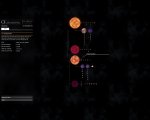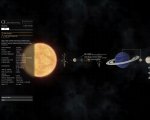You are using an out of date browser. It may not display this or other websites correctly.
You should upgrade or use an alternative browser.
You should upgrade or use an alternative browser.
Post your weird systems!
- Thread starter Surly_Badger
- Start date
Just goes on and on..........


Minimalist:
The comma in British English is a thousand separator, right?
That makes that black hole 15 billion (short scale) years old, older than the 13.8 billion years of the universe!
Last edited:
The comma in British English is a thousand separator, right?
That makes that black hole 15 billion (short scale) years old, older than the 13.8 billion years of the universe!
lol, when I opened up badgers image the first time all I saw was the star, didnt even see the black hole....
Minimalist:
The comma in British English is a thousand separator, right?
That makes that black hole 15 billion (short scale) years old, older than the 13.8 billion years of the universe!
Yes that is weird. Sounds like a bug?
Deleted member 38366
D
-- Deleted --
Last edited by a moderator:
I'm currently exploring the nebula NGC xxxx (forgot number, some 2500 ly west of sol). It has lots of class O stars (blue giants). Funny enough the description states that these stars rarely have ages > 10 million years, but most I found showed ages a lot higher than that (50-100 million years).
Speaking of weird: This whole nebula has given me a very strange feeling. Super giant blue stars, orbited by many other stars (instead of planets). And all of the time you have the red background of the nebula. Makes for a very eerie experience, tbh. I'll be glad if I leave this place and can explore "normal" systems again
Speaking of weird: This whole nebula has given me a very strange feeling. Super giant blue stars, orbited by many other stars (instead of planets). And all of the time you have the red background of the nebula. Makes for a very eerie experience, tbh. I'll be glad if I leave this place and can explore "normal" systems again
Last edited:
I didn't get to tag this system, its an O-star in IC 1805 or thereabouts, in the Perseus Arm in the vicinity of Heart & Soul. It may be from the other open cluster in that area, the one that also has an IC Some-Number-Related-To-Napoleon.
Its not so much a system as a small cluster.
So, by all means congrats to CMDR Pennypacker who tagged it:

Its not so much a system as a small cluster.
So, by all means congrats to CMDR Pennypacker who tagged it:

The comma in British English is a thousand separator, right?
That makes that black hole 15 billion (short scale) years old, older than the 13.8 billion years of the universe!
I totally did not notice that!!!!
Time to enter that in the record book. Nice catch!
- - - Updated - - -
There once was a ring.
That's one weird system there!! WOW!!!!!!
I know this is just a problem of scale in the chart, but it'd be fascinating if the system actually looked like this. There'd be quite the accretion disk from those rings getting gobbled by that black hole...
I flew up close to the beringed one and saw no rings.
It seems to me that if you mouse over the gap between two astronomical objects it ought to tell you the distance between them and their anchor.
I flew up close to the beringed one and saw no rings.
It seems to me that if you mouse over the gap between two astronomical objects it ought to tell you the distance between them and their anchor.
Last edited:
@Thoris NCG 7822?
That's the one!
A planet with such a strong greenhouse effect and internal radioactivity that it was reporting around 2000K hotter than the star it orbited...
Given the atmospheric pressure and composition I suspect this planet is actually a small gas giant made of silicate and metal vapour rather than hydrogen, and the scanner just didn't know how to cope.
I didn't discover it - too close to Sol for that - but I expect this is exactly the sort of planet UC want verification of the original reports for.
Given the atmospheric pressure and composition I suspect this planet is actually a small gas giant made of silicate and metal vapour rather than hydrogen, and the scanner just didn't know how to cope.
I didn't discover it - too close to Sol for that - but I expect this is exactly the sort of planet UC want verification of the original reports for.
Last edited:
I wonder if the game has more black holes older than the universe, and if this is a bug in the star forge that needs adressing.I totally did not notice that!!!!
Time to enter that in the record book. Nice catch!
Was it a record?
Two things come to mind, don't have the pics to post right now though..
1) Red giants that are really small. Visited at least two of these. Didn't look special, but registered as giant. Radius was around 0.25 so not that different from red dwarfs (or are they?).
2) O-class stars. Every O system is interesting because you never know what to expect. The best was this very small, very dense and extremely hot O-star, which had very fast rotation and scared the space food out of me.
1) Red giants that are really small. Visited at least two of these. Didn't look special, but registered as giant. Radius was around 0.25 so not that different from red dwarfs (or are they?).
2) O-class stars. Every O system is interesting because you never know what to expect. The best was this very small, very dense and extremely hot O-star, which had very fast rotation and scared the space food out of me.
Ringed Neutron Star next to Black Hole:














